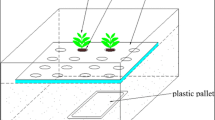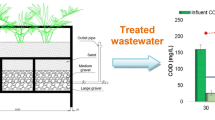Abstract
A modularized and air adjustable constructed submerged plant bed (CSPB) which can be used to restore the eutrophic water is introduced in this paper. This plant bed helps hydrophyte grow under poor conditions such as frequently changed water depth, impaired water transparency, algae bloom and substantial duckweed in summer, which are not naturally suitable for growing hydrophyte. This pilot study in Waihuan River of Tianjin, China, revealed that reduction of Chemical Oxygen Demand (COD), Total Nitrogen (TN) and Total Phosphorus (TP) by the use of CSPB could be reached 30%–35%, 35%–40%, 30%–40% respectively in the growing season (from March to October) and 5%–10%, 5%–15%, 7%–20% respectively in the winter (from November to February) when the detention time was 6 d. The relationships between the concentration of COD, TN, TP and the detention time fit the first-order kinetic equation well and the coefficients of determination (R 2) were all above 0.9. The attenuation coefficients k of the kinetic equation were a function of the water temperature. When the water temperature was quite low or quite high, k was not significantly changed with increasing or decreasing water temperature. While when the temperature was in a moderate range, an increase or decrease of water temperature would lead to a rapid increase or decrease in k.
Similar content being viewed by others
References
Tanner C C. Plants for constructed wetland systems-a comparison of the growth and nutrient uptake of eight emergent species. Ecological Engineering, 1996, 7(1): 59–83
Hughes J B, Shanks J, Vanderford M, Lauritzen J, Bhadra R. Transformation of TNT by aquatic plants and plant tissue cultures. Environmental Science & Technology, 1997, 31(1): 266–271
Ingersolla T L, Bakera L A. Nitrate removal in wetland microcosms. Water Research, 1998, 32(3): 677–684
Groudeva V I, Groudev S N, Doycheva A S. Bioremediation of waters contaminated with crude oil and toxic heavy metal. International Journal of Mineral Processing, 2001, 62(1–4): 293–299
Bankston J L, Sola D L, Komor A T, Dwyer D F. Degradation of trichloroethylene in wetland microcosms containing broad-leaved cattail and eastern cottonwood. Water Research, 2002, 36(6): 539–1546
Dierberg F E, de Busk T A, Jackson S D, Chimney M J, Pietro K. Submerged aquatic vegetation-based treatment wetlands for removing phosphorus from agricultural runoff: response to hydraulic and nutrient loading. Water Research, 2002, 36(6): 1409–1422
Li J Z, Li X J. The development of study on water quality improvement by using constructed submerged plant bed. Journal of agro-environment science, 2006, 25(suppl.): 825–830 (in Chinese)
Zhang X B, Liu P, Yang Y S, Chen W R. Phytoremediation of urban wastewater by model wetlands with ornamental hydrophytes. Journal of Environmental Sciences, 2007, 19(8): 902–909
Kubin P, Melzer A. Chronological relationship between eutrophiction and reed decline in three lakes of southern Germany. Folia Geobotanica et Phytotaxonomica, 1997, 32(1): 15–23
Shang S Y, Du J M, Li X Y, Shen Q T, Hou F X, Wu L B. Experimental study on improving ecological conditions through harvesting submerged plants in a vegetation rich lake. Journal of Agricultural Engineering, 2003, 19(6): 95–100 (in Chinese)
Wu Z B, Qiu D R, He F, Fu G P, Cheng S P, Ma J M. Effects of rehabilitation of submerged macrophytes on nutrient level of a eutrophic lake. Journal of Applied Ecology, 2003, 14(8): 1351–1353 (in Chinese)
Yue W Z, Huang X P, Huang L M, Tan Y H, Yin J Q. Preliminary study on purification of mariculture water by macroscopic algae. Marine Environmental Science, 2004, 23(1): 13–15 (in Chinese)
Xu D L, Liu Z W, Zeng Y, Wang H J. Effect of phragmites communities on the sediment of Taihu Lake. Journal of China University of Mining & Technology, 2005, 34(2): 148–151 (in Chinese)
Brix H. Functions of macrophytes in constructed wetlands. Water Science and Technology, 1994, 29(4): 71–78
Pempkowiak H O, Ozimek T, Haustein E. The removal of biogenic compounds and suspended solids in a constructed wetland system. Polish Journal of Environmental Studies, 2002, 11(3): 261–266
Tong C H, Yang X E, Pu P M. Effects and mechanism of hydrophytes on control of release of nutrient salts in lake sediment. Journal of Agro-environment Science, 2003, 22(6): 673–676 (in Chinese)
Faisal M, Hasnain S. Beneficial role of hydrophytes in removing Cr(VI) from wastewater in association with chromate-reducing bacterial strains Ochrobactrum intermedium and Brevibacterium. International Journal of Phytoremediation, 2005, 7(4): 271–277
Wan X H, Li X D, Wang Y C, Lu J, Zhao Y Y, Liu L H, Zhou H D. Simulation of removal ammonia and nitrate from wetlands constructed by different hydrophytes. Journal of Lake Sciences, 2008, 20(3): 327–333 (in Chinese)
Shaltout K H, Galal T M, Komi T M E. Evaluation of the nutrient status of some hydrophytes in the water courses of Nile Delta, Egypt. Journal of Botany, 2009, 20(1): 1–11
Zhu M, Sun J J, Xu Y T. Water purification and ecotype maintenance in landscape water-body. Shanghai Environmental Sciences, 2003, 22(suppl.): 159–164 (in Chinese)
Chong Y X, Hu H Y, Qian Y. Advances in utilization of macrophytes in water pollution control. Techniques and Equipment for Environmental Pollution Control, 2003, 4(2): 36–40 (in Chinese)
Dong X D, Zhou Q, Zhou X D. Technology and development of pollution prevention and treatment on rivers and lakes in China. Geology and Resource, 2004, 13(1): 26–29 (in Chinese)
Zhu W, Chen Q J, Zhang L F. Purification effect of polluted water in low temperature in winter by Elodea nuttallii. Ecology & Environment, 2004, 13(4): 497–499 (in Chinese)
Ma J Q, Zhou H D, Dong Z R. Study on aquatic macrophytes for purification of eutrophic water. Journal of China Institute of Water Resources and Hydropower Research, 2005, 3(2): 130–135 (in Chinese)
Stoltz E, Greger M. Accumulation properties of As, Cd, Cu, Pb and Zn by four wetland plant species growing on submerged mine tailings. Environmental and Experimental Botany, 2002, 47(3): 271–280
Demirezen D, Aksoy A. Accumulation of heavy metals in Typha angustifolia (L.) and Potamogeton pectinatus (L.) living in Sultan Marsh (Kayseri, Turkey). Chemosphere, 2004, 56(7): 685–696
Miretzky P, Saralegui A, Cirelli A F. Aquatic macrophytes potential for the simultaneous removal of heavy metals (Buenos Aires, Argentina). Chemosphere, 2004, 57(8): 997–1005
Keskinkan O, Goksu M Z, Basibuyuk M, Forster C F. Heavy metal adsorption properties of a submerged aquatic plant (Ceratophyllum demersum). Bioresource Technology, 2004, 92(2): 197–200
Keskinkana O, Goksu M Z L, Yuceer A, Basibuyuk M. Comparison of the adsorption capabilities of myriophylum spicatum and ceratophyllum demersum for zinc, copper and lead. Engineering in Life Sciences, 2007, 7(2): 192–196
Maleva M G, Nekrasova G F, Bezel V S. The response of hydrophytes to environmental pollution with heavy metals. Russian Journal of Ecology, 2007, 35(4): 230–235
Cheng S P, Grossea W, Karrenbrock F. Thoennessenc M. Efficiency of constructed wetlands in decontamination of water polluted by heavy metals. Ecological Engineering, 2001, 18(3): 317–325
Xian QM, Chen H D, Zou H X, Yi D Q. Analysis of organic acids in aqueous leachates of three submerged macrophytes. Journal of Plant Resources and Environment, 2004, 13(3): 57–58 (in Chinese)
Yang C S, Lan C Y, Shu W S. Study on the Efficiency of broadleaved cattail constructed wetlands to treat waste water from plumbum, zinc mine. Journal of Shenzhen University, 2000, 17(2): 51–57 (in Chinese)
Xian Q M, Chen H D, Zou H X, Yi D Q, Gong H J, Qu L J. Allelopathic effects of four submerged macrophytes on microcystis aeruginosa. Journal of Lake Sciences, 2005, 17(1): 75–80 (in Chinese)
Dai S G, Zhao F, Jin Z H, Zhuang Y Y, Yuan Y C. Algae-restraint Efficiency of compound extracted from bulrush and the method of extracting and identify. Journal of Environmental Chemistry, 1997, 16(3): 268–271 (in Chinese)
He C Q, Ye J X. Study on algae-restraint Efficiency of calamus. Journal of Ecology, 1999, 19(5): 754–758 (in Chinese)
Cui X H, Xiong B H, Pu Y H, Li W, Chen J K, He G Q. Comparative Study of regeneration and colonization ability in five submersed macrophytes. Acta Phytoecologica Sinica, 2000, 24(4): 502–505 (in Chinese)
Niu X Y, Ge Y, Wang X Y, Xu Q S, Chang J. Comparison on difference of the purification ability to eutrophic water between five plants in different sunlight conditions. Bulletin of Science and Technology, 2001, 17(2): 1–4 (in Chinese)
Baldantoni D, Alfani A, Di Tommasi P, Bartoli G, De Santo A V. Assessment of macro and microelement accumulation capability of two aquatic plants. Environmental Pollution, 2004, 130(2): 149–156
Huang L, Zhai J P, Nie R, Wang C Y, Jiang X Y. Experimental study of decontamination and resistance ability of five hydrophytes. Research of Environmental Sciences, 2005, 18(3): 33–38 (in Chinese)
Li Z Y, Tang Y L, Yang Z J, Yue C L. Current situation of study on plants on constructed wetland. Journal of Zhejiang Forestry Science and Technology, 2004, 24(7): 56–59 (in Chinese)
Huang L, Zhai J P, Wang C Y, Nie R, Yuan D H. Removals of nitrogen and phosphorus in Taihu Lake water by four hydrophytes in winter season. Journal of Agro-environment Science, 2005, 24(2): 366–370 (in Chinese)
Sorrell B K, Armstrong W. On the difficulties of measuring oxygen release by root systems of wetland plants. Journal of Ecology, 1994, 82(1): 177–183
Deng F T, Sun P S, Li Q, Wu G, Deng F S. Study on decontaminating sewage and utilizing of wetland plants. Ecological Economics, 2005, 4: 66–69 (in Chinese)
Wang G X, Pu P M, Zhang S Z, Hu C H, Hu W P. The purification ability of aquatic macrophytes for eutrophic lake in winter. China Environmental Science, 1999, 19(2): 106–109 (in Chinese)
Cheng X Y, Wang G X, Pu P M, Zhang S Z, Chen B J. Restoration and purification of macrophytes in a eutrophic lake during autumn and winter. Journal of Lake Sciences, 2002, 14(2): 139–144 (in Chinese)
Zhu L, Miao W H, Yan Y. Comments on biologic-ecological rehabilitation techniques for rivers and lakes. Journal of Hohai University (Natural Sciences Version), 2005, 23(1): 59–62 (in Chinese)
Li W C, Lian G H. Light demands for brood-bud germination of submerged plant. Journal of Lake Sciences, 1996, 8(Suppl.): 25–29 (in Chinese)
Cheng N N, Zhu W, Zhang J. Reproduction and plantation technique of submerged macrophyte in polluted water. Water Resources Protection, 2004, 20(6): 8–12 (in Chinese)
Xie T, Zhu F S, Guan Y. Tentative experimental results of raising grass in box with net to purify the water quality. Yunnan Environmental Sciences, 2004, 23(3): 58–62 (in Chinese)
Author information
Authors and Affiliations
Corresponding author
Rights and permissions
About this article
Cite this article
Li, J., Li, X., Sun, S. et al. Restoration of hyper-eutrophic water with a modularized and air adjustable constructed submerged plant bed. Front. Environ. Sci. Eng. China 5, 573–584 (2011). https://doi.org/10.1007/s11783-011-0363-x
Received:
Accepted:
Published:
Issue Date:
DOI: https://doi.org/10.1007/s11783-011-0363-x




